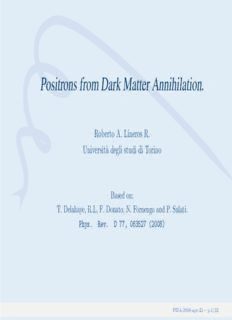
Positrons from Dark Matter Annihilation. PDF
Preview Positrons from Dark Matter Annihilation.
PositronsfromDarkMatterAnnihilation. Roberto A. Lineros R. Universit`a degli studi di Torino Based on: T. Delahaye, R.L, F. Donato, N. Fornengo and P. Salati. Phys. Rev. D 77, 063527 (2008) PISA-2008-apr-21 – p.1/32 Motivation To study positron/electron Cosmic Rays (CR) signals and its potential to reveal new exotic signals. To study indirect searches of galactic Cold Dark Matter (CDM) To study uncertainties related to particle and astrophysics, for disentangle new signals from background. PISA-2008-apr-21 – p.2/32 Outline • Cold Dark Matter * Properties, distribution, candidates. • CR and propagation * Two–Zone Propagation Model, Transport Equation (TE). • Positron/Electron CRs * TE and solutions, Halo Function * Fluxes, Positron fraction, comparison with data * Predictions for PAMELA and AMS02 • Conclusions PISA-2008-apr-21 – p.3/32 Cold Dark Matter Large structures dynamics, gravitational lensing, CMB observation, BBN, BAO . . . • Electrically neutral • Almost collisionless matter • Non-barionic • Cold from combined measurements give : (E. Komatsu et al. 2008) 2 Ω h ≃ 0.105 CDM PISA-2008-apr-21 – p.4/32 CDM in galaxies It is well accepted that CDM forms structures. and galaxies are embedded into CDM haloes. (Mathis et al. 2002) PISA-2008-apr-21 – p.5/32 CDM in galaxies The CDM haloes are generically described by a smooth distribution. (β−γ)/α α r γ 1 + r /r ⊙ ⊙ s ρ(r) = ρ ⊙ α r 1 + r/r (cid:0) s (cid:1) ! (cid:16) (cid:17) (cid:0) (cid:1) + Milky Way’s case: r = 8.5[kpc], z = 0[kpc] ⊙ ⊙ 3 ρ = 0.3[GeV/cm ] ⊙ PISA-2008-apr-21 – p.6/32 CDM in galaxies Most common profiles are: Halo profile α β γ r [kpc] s Cored isothermal 2 2 0 5 NFW 1 3 1 20 Moore 1.5 3 1.3 30 100 isothermal ] NFW 3 − 10 Moore m c V e G 1 [ M 0.1 D C ρ 0.01 0.1 1 10 100 r [kpc] PISA-2008-apr-21 – p.7/32 DM theoretical perspectives The DM’s nature is not completely clear. We just know many properties of it. Candidates for a DM particle candidate are proposed in theories BSM: • Neutralinos, sneutrinos, gravitinos from SUSY-side. • Kaluza-Klein particle from Extra-Dimension. • Heavy neutrinos, axions . . . • among others. PISA-2008-apr-21 – p.8/32 DM searches There are different ways to search for DM: Direct detection: By measuring recoil energy produced by elastic scattering between detector and DM particle. Experiments: CDMS, CRESST, EDELWEISS , DAMA, among others. DM production: For some BSM models, LHC will be able to produce DM candidate particles. PISA-2008-apr-21 – p.9/32 DM searches Indirect detection: CDM may annihilate and act as an exotic source of CR, photons, neutrinos, etc. Experiments: HEAT, CAPRICE, AMS, PAMELA, AMANDA, EGRET, MASS . . . PISA-2008-apr-21 – p.10/32
Description: